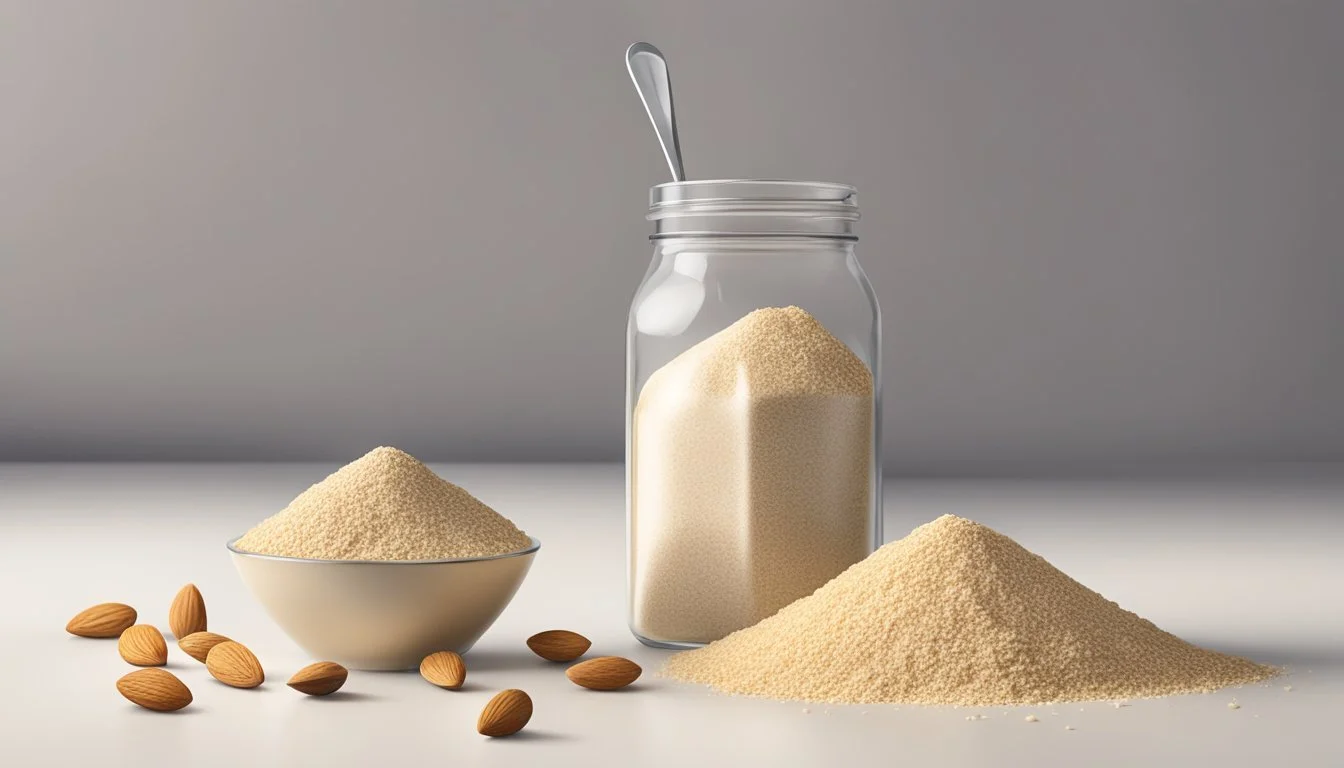How many tablespoons in a pound of almond meal?
Quick Measurement Guide
When measuring ingredients for baking or cooking, accuracy is crucial for the success of a recipe. Almond meal, a flour substitute made from finely ground almonds, is often used for gluten-free and low-carbohydrate recipes. Determining the conversion from weight to volume can be particularly important for those who prefer or need to measure ingredients by volume.
A pound of almond meal translates to approximately 72.5 US tablespoons. This conversion is handy for those looking to use almond meal in their culinary endeavors, as it allows for precise measurements without the need for a kitchen scale. It is essential, however, to take into account that the conversion can be influenced by factors such as the fineness of the grind and the compaction of the almond meal in the measuring spoon.
For those incorporating almond meal into their cooking, understanding this conversion provides a foundation for consistency in recipes. It ensures that the proportion of almond meal is accurate, which is particularly important in baked goods where the balance of dry to wet ingredients affects the texture and structure of the final product. With a clear and confident grasp of these measurements, home cooks and professional chefs alike can use almond meal to its full potential.
Almond Meal Basics
In exploring almond meal, one must understand its definition, differentiate it from almond flour, and consider its nutritional value to make informed choices in cooking and baking.
Defining Almond Meal
Almond meal is a ground food product made by grinding whole almonds. It typically includes the almond skins and has a coarser texture compared to almond flour. Almond meal can be made at home using raw almonds and a food processor or can be purchased pre-made.
Almond Meal vs. Almond Flour
Almond flour, often confused with almond meal, is made from blanched almonds with the skins removed before grinding, resulting in a finer and lighter product. While both can be used interchangeably in recipes, almond flour is better suited for delicate confections, and almond meal for more robust, textured baked goods.
Nutritional Profile
The nutritional profile of almond meal is impressive:
Protein: Almond meal is a source of plant-based protein, contributing to muscle repair and growth.
Fiber: It is high in dietary fiber, which aids in digestion and provides a feeling of fullness.
Calories: It is calorie-dense due to its fat content, making it energy-rich.
Nutritional Facts: Almond meal contains various vitamins and minerals, including Vitamin E, magnesium, and potassium.
Almond meal's nutritional content makes it a healthy addition to many diets, offering a gluten-free alternative to traditional wheat flours.
Measurement Conversions
When preparing recipes, accuracy in measurement conversion is crucial, particularly when dealing with ingredients like almond meal where volume and weight differ. This clear guide provides the necessary data for converting between tablespoons and pounds of almond meal.
Volume to Weight Conversion
To convert volume to weight when measuring almond meal, the standard is that one pound of almond meal is equivalent to 72.5 US tablespoons. Here is a simple reference chart for smaller conversions:
US Tablespoons Almond Meal (pounds) 1 0.0138 5 0.0688 10 0.1377 15 0.2065 20 0.2753
Measuring by Weight
Measuring almond meal by weight ensures accuracy. A kitchen scale can be used to measure out the desired weight directly. For instance, if a recipe calls for half a pound of almond meal, simply weigh out 8 ounces on the scale. This method provides the most reliable way to achieve consistent results in cooking and baking.
Almond Meal in Cooking and Baking
Almond meal is commonly used in cooking and baking as a versatile ingredient known for enhancing flavor and providing a nutritious alternative to traditional flours.
Use in Bread and Cookies
In bread recipes, almond meal contributes a nutty flavor and moist texture, often used in conjunction with wheat flours to bolster the protein content and add a unique twist. For cookies, almond meal is especially popular in recipes like chocolate chip cookies, where it can replace all or some of the standard flour to create a tender crumb and a slightly chewy texture.
Texture and Flavor Contributions
The addition of almond meal to baked goods imparts a distinctive texture and rich flavor that can elevate the overall taste profile. Its slightly coarse consistency introduces a pleasant, subtle crunch to the exterior of baked items, while its inherent buttery and sweet taste complements ingredients such as chocolate, fruit, and spices.
Substituting Almond Meal
When substituting almond meal in recipes:
Consistency: Due to its lack of gluten, almond meal does not bind as wheat flour does, which can affect the structure of baked goods.
Moisture: Almond meal tends to retain more moisture. Recipes may need to be adjusted to prevent a soggy outcome.
Flavor: Almond meal adds a nutty flavor, which can be a delightful addition or an overpowering element, depending on the intended taste of the dish.
It is recommended to incorporate almond meal gradually into recipes, starting with a partial substitution, to achieve the desired result without compromising the dish's integrity.
Health and Nutrition
When considering the health and nutrition aspects of almond meal, it's important to focus on its fat composition, essential vitamins and minerals, and its utility in special diets due to its unique nutritional profile.
Fat Content and Types
Almond meal is rich in fats, predominantly the heart-healthy monounsaturated and polyunsaturated types. A standard serving can offer a substantial amount of these beneficial fats, which are known for their positive effects on cardiovascular health. Specifically, almond meal contains both monounsaturated fat and polyunsaturated fat, which can help maintain normal cholesterol levels.
Vitamins and Minerals
A significant aspect of almond meal's nutritional value lies in its vitamin and mineral content. One ounce of almonds provides 37% of the recommended daily intake of vitamin E, an antioxidant that supports immune function. Moreover, almond meal contributes to the body's iron, magnesium, potassium, calcium, and manganese intake. These minerals play crucial roles in bone health, nerve and muscle function, and metabolism.
Vitamin/Mineral Percentage of Daily Value (DV) Vitamin E 37% (approximate value for 1 oz of almonds) Calcium 8% (approximate value for 1 oz of almonds) Iron 6% (approximate value for 1 oz of almonds)
Dietary Considerations
Almond meal is a favorable ingredient for various diets, including low carb and gluten-free lifestyles, due to its low carbohydrate content. One teaspoon of almond meal contains only half a gram of carbs and a minimal 0.1g of sugars. Additionally, its dietary fiber, at 0.24g per teaspoon, is beneficial for digestive health. The nutritional aspects of almond meal allow it to serve as a versatile and nutritious flour alternative, especially for those monitoring their carbohydrate intake or with specific dietary restrictions.
Almond Meal Preparation
Creating almond meal from scratch ensures a fresh, pure product that can be used for various culinary applications. The process requires basic kitchen equipment and raw almonds.
Making Homemade Almond Meal
Homemade almond meal can be prepared using raw almonds. One needs a high-speed blender or a food processor to achieve a fine consistency. The simple steps to make almond meal are as follows:
Measure: Start with the desired amount of raw almonds.
Blend: Place the almonds in a high-speed blender.
Process: Blend on the highest setting for about 10 seconds.
Check: Pause to check for clumps and pulse as needed until fine.
Sieve: For a finer texture, sift the meal to remove larger particles.
This method provides one with fresh almond meal that's ideal for baking and cooking.
Blanching and Processing
Alternatively, one might opt to use blanched almonds for a lighter-colored meal. The blanching process involves:
Soaking: Briefly boiling almonds in water.
Peeling: Removing the skins by pinching the almonds.
Drying: Ensuring the blanched almonds are completely dry.
Grinding: Processing the blanched almonds as per the previous steps.
This variation is typically used for recipes where a more refined texture and appearance are desired.
Dietary Concerns and Alternatives
Choosing alternatives to almond meal is important for individuals with dietary restrictions or allergies. This section provides specific options that cater to different dietary requirements.
Nut Allergies
For those with nut allergies, almond meal is not a suitable option due to the potential for severe allergic reactions. As a safe and common substitute, individuals can consider using sunflower seed flour or pumpkin seed meal, which offer similar consistency and health benefits without the risk of nut allergens.
Gluten-Free and Vegan Alternatives
Almond meal is naturally gluten-free and vegan, making it a popular choice for individuals following these diets. However, if almond meal is not suitable, one can opt for coconut flour or rice flour, which are also gluten-free and vegan. These alternatives provide versatility and can be used in various recipes that require a gluten-free or vegan ingredient.
Gluten-Free Alternatives:
Oat Flour (ensure it's certified gluten-free)
Vegan Alternatives:
Soy Flour
Lentil Flour
Low-Carb and Paleo Options
For individuals adhering to a low-carb or paleo diet, almond meal is a frequently used ingredient due to its low carbohydrate content and compatibility with paleo guidelines. When seeking alternatives, hazelnut meal and flaxseed meal are excellent choices that maintain the low-carb aspect and are fully paleo-friendly.
Paleo and Low-Carb Substitutes:
Hazelnut Meal
Coconut Flour (note that it's higher in carbs than almond meal but still suitable for a paleo diet)
Storage and Shelf Life
Almond meal, when stored properly, can have a significant shelf life. The key to prolonging the freshness of almond meal lies in its storage conditions. It should be kept in a cool and dry place, with temperatures ranging ideally between 32°F (0°C) and 50°F (10°C). To ensure maximum freshness, almond meal is best stored in an airtight container to prevent exposure to moisture, which can lead to spoilage.
Refrigeration: Almond meal can benefit from refrigeration, particularly if one intends to extend its usability period beyond immediate consumption timeframes. Refrigerated almond meal remains usable for several months, given that the cooling environment slows down the oxidation process.
Freezer Storage: For even longer shelf life, freezing almond meal is a recommended practice. In a freezer, almond meal can be kept for up to a year without significant loss of quality.
It is imperative to note that the storage area should be kept away from strong odors and heat sources, as almond meal can absorb strong smells and become rancid if exposed to heat.
Packaging: The importance of proper packaging cannot be overstated. An airtight container not only protects the almond meal from external contaminants but also ensures that the natural oils present within the nuts do not oxidize prematurely.
By following these storage guidelines, one can expect to maintain the quality of almond meal for an extended period, making it a reliable ingredient ready for use in various recipes.








